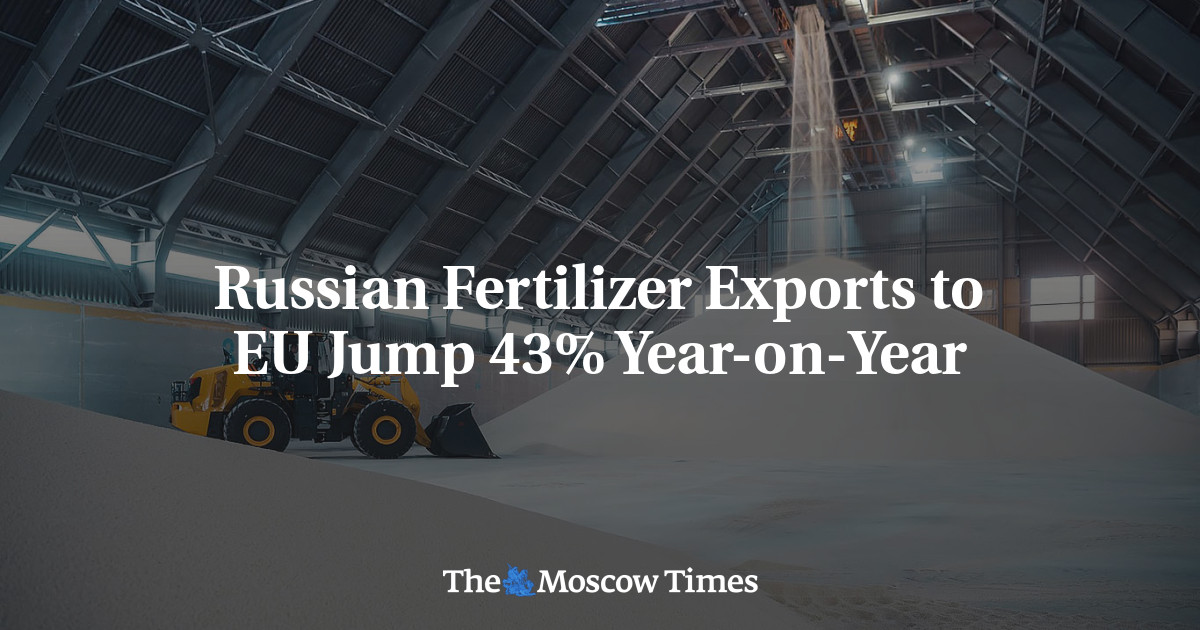Russian Fertilizer Exports to EU Jump 43% Year-on-Year – The Moscow Times

Exports of Mineral Fertilizers from Russia to the European Union Increase by 43% YoY

According to data from Metals & Mining Intelligence (MMI), exports of mineral fertilizers from Russia to the European Union (EU) have increased by 43% year-on-year in August, reaching 3.3 million tons. This significant growth in exports is also reflected in monetary terms, with a 32% increase to 1.1 billion euros ($1.21 billion).
Major Exporter of Fertilizers
Russia continues to be a major exporter of fertilizers that have not been sanctioned, as reported by bne IntelliNews. This highlights the country’s contribution to the global fertilizer market and its commitment to sustainable development goals.
Breakdown of Exported Fertilizers
The majority of fertilizer exports in August were complex fertilizers, which contain several nutrients. Shipments of complex fertilizers grew by 1.8 times compared to August 2023, reaching 1.2 million tons. Potash fertilizer exports to the EU increased even more significantly, by 2.6 times, totaling 0.37 million tons. Nitrogen fertilizer exports also saw a 13% year-on-year increase, reaching 1.7 million tons.
Top Buyers in the EU
The largest buyers of Russian fertilizers in the EU were Poland, France, and Germany. Poland increased its imports by 2.7 times compared to the previous year, while France increased its imports by 18%. However, Germany reduced its purchases by 17%.
Reasons for Growth in Exports
The growth in fertilizer exports to the EU can be attributed to higher production costs for local producers. This year, they have been affected by higher natural gas prices. Additionally, the availability of fertilizers from other European countries has been limited due to the conflict in the Middle East and more complicated supply logistics.
The rise in fertilizer production costs in the EU, especially for nitrogen fertilizers, is primarily due to the surge in gas prices for ammonia, the raw material used in their production. Fertilizer production is energy-intensive, and the increased gas prices have forced major European producers, such as Poland’s ANWIL and Grupa Azoty, as well as Lithuania’s Achema, to suspend production.
Russia’s Leading Role in Fertilizer Production
According to the UN Food and Agriculture Organization, Russia is the world’s largest exporter of nitrogen fertilizers and the leading exporter of potash and phosphate fertilizers. The country’s largest fertilizer producers include Uralchem Group (including Uralkali), Phosagro, Acron, and Eurochem. In the first eight months of 2024, Russia’s fertilizer production increased by 12% to 18.8 million tons of active ingredients. Ammonia output also rose by 6% to 12 million tons.
This article was originally published by bne IntelliNews.
SDGs, Targets, and Indicators
1. Which SDGs are addressed or connected to the issues highlighted in the article?
- SDG 2: Zero Hunger
- SDG 7: Affordable and Clean Energy
- SDG 8: Decent Work and Economic Growth
- SDG 12: Responsible Consumption and Production
- SDG 13: Climate Action
2. What specific targets under those SDGs can be identified based on the article’s content?
- SDG 2.3: By 2030, double the agricultural productivity and incomes of small-scale food producers, in particular women, indigenous peoples, family farmers, pastoralists, and fishers, including through secure and equal access to land, other productive resources and inputs, knowledge, financial services, markets, and opportunities for value addition and non-farm employment.
- SDG 7.2: By 2030, increase substantially the share of renewable energy in the global energy mix.
- SDG 8.2: Achieve higher levels of economic productivity through diversification, technological upgrading, and innovation, including through a focus on high-value added and labor-intensive sectors.
- SDG 12.4: By 2020, achieve the environmentally sound management of chemicals and all wastes throughout their life cycle, in accordance with agreed international frameworks, and significantly reduce their release to air, water, and soil to minimize their adverse impacts on human health and the environment.
- SDG 13.2: Integrate climate change measures into national policies, strategies, and planning.
3. Are there any indicators mentioned or implied in the article that can be used to measure progress towards the identified targets?
- Indicator for SDG 2.3: Agricultural productivity and incomes of small-scale food producers
- Indicator for SDG 7.2: Share of renewable energy in the global energy mix
- Indicator for SDG 8.2: Economic productivity through diversification, technological upgrading, and innovation
- Indicator for SDG 12.4: Environmentally sound management of chemicals and wastes
- Indicator for SDG 13.2: Integration of climate change measures into national policies and planning
4. Table: SDGs, Targets, and Indicators
| SDGs | Targets | Indicators |
|---|---|---|
| SDG 2: Zero Hunger | 2.3: By 2030, double the agricultural productivity and incomes of small-scale food producers | Agricultural productivity and incomes of small-scale food producers |
| SDG 7: Affordable and Clean Energy | 7.2: By 2030, increase substantially the share of renewable energy in the global energy mix | Share of renewable energy in the global energy mix |
| SDG 8: Decent Work and Economic Growth | 8.2: Achieve higher levels of economic productivity through diversification, technological upgrading, and innovation | Economic productivity through diversification, technological upgrading, and innovation |
| SDG 12: Responsible Consumption and Production | 12.4: By 2020, achieve the environmentally sound management of chemicals and all wastes throughout their life cycle, in accordance with agreed international frameworks, and significantly reduce their release to air, water, and soil to minimize their adverse impacts on human health and the environment | Environmentally sound management of chemicals and wastes |
| SDG 13: Climate Action | 13.2: Integrate climate change measures into national policies, strategies, and planning | Integration of climate change measures into national policies and planning |
Source: themoscowtimes.com








